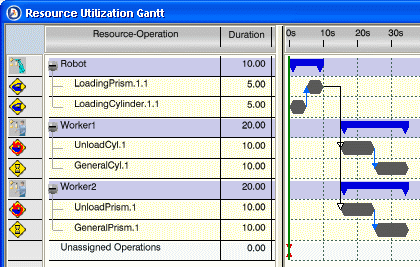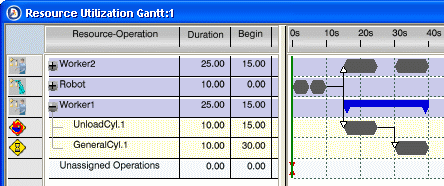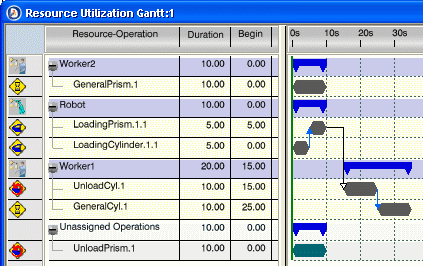About the Resource Utilization Gantt | |||||||
|
| ||||||
How to Open a Resource Utilization Gantt
The Resource Utilization Gantt is opened by selecting the Resource Utilization Gantt in the Gantt Commands toolbar then selecting a resource. It is also possible to select one or more resources and then select the command.
Multi-selection of resources is possible for the Resource Utilization Gantt from the tree or the 3D view.
In this case, the Gantt chart can have several root resources.

Several Resource Utilization Gantt charts can be opened simultaneously on different Working resources (multi-selection is allowed).
A Manufacturing System Gantt can be opened at same time as a Resource Utilization Gantt.
Note that a suitable Resource-System scope must be defined, otherwise a warning message is issued and the Resource Utilization Gantt is not opened. For example, you cannot open the Gantt chart on a father resource when the scope is specified between a child resource and a system.
![]()
Columns in the Resource Utilization Gantt
The columns of the Manufacturing System Gantt chart display information about systems, resources, operations, parts, and fasteners. Any of the columns (except Resource-Operation) can be hidden/shown by right-clicking in the header area and deselecting/selecting any of the column check box options.
The columns in this Gantt chart are as follows:
- Resource-Operation: Displays a tree view of the resources and assigned operations. Unassigned operations are also listed in a separate node.
- Duration: Difference between the start and end time.
- Begin Time: Start time of an operation.
- End Time: End time of an operation.
- Idle Time: Time during which the resource is not used.
- Type: resource type (organizational, worker, and so on).
- Utilization: Percentage of time for which a resource is utilized.
- Associated Parts: Instance names of the assigned parts of an operation. Parts may be displayed as a list with a separator (,).
- Type of Time: Estimated, simulated, or analyzed time of an operation.
- Number of Fasteners: Displays the number of assigned fasteners for operation and resources. The first number on the resource indicates the number of fasteners assigned directly to this resources behavior. The number in brackets is the sum of the fasteners assigned to the resources direct behavior and all fasteners assigned to all child behavior.
- Localized Resource: The organizational resource assigned to the operation.
- Used Resource(s): The non-working resources assigned to the operation.
- Resource used for positioning: The resource used for parts positioning for a given operation.
To hide/show any of the columns (except Resource-Operation), right-click in the column header area and deselect/select any of the column check box options.
To change the column size, place your cursor over the edge of the column (the cursor changes to arrow shape). Move the cursor left or right to change the column size.
To move a column, select the column (the cursor changes to hand shape). Move the selected column to left or right as required.
Note that you can use the Customize Column(s) contextual command to customize the columns of the Gantt chart with operation, system and resource attributes or any new customized attributes.
![]()
Which Objects are Displayed
For a given working resource, the Resource Utilization Gantt displays the list of operations that it executes. It takes into account the other working and organizational resources that "aggregate" the working resource.
Working Resources
Working resources are as follows:
- Worker
- Robot
- NC Machine
- Industrial Machine
- Inspect
- Transport
- Conveyor
- Logic Controller
- Control Device.
Operation Colors
You can assign colors to operations in the Gantt chart.
You can assign the same color to operations:
-
which belong as the same system
-
which are assigned to the same resource.
This is done by means of the Color in Gantt View contextual command and the two color modes, which are also available in the contextual menu: Color by System and Color by Resource.

The selected color is applied to all the operations of the Gantt. The behavior is the same whether you select the root System or root Resource, or a child System or a child Resource node.
![]()
How Objects are Displayed
Operations can displayed in a collapsed or expanded view. Error cases (overlapping operations, for example) are highlighted in red.
Collapse and Expand View
In the collapsed view (when no overlapping problem occurs): operations are displayed in same line.
When two operations are done by the same resource and a delay exists, a blank space in inserted on the collapsed view.

In the expanded view:
-
One line per operation: the constraints between operations are symbolized by an arrow.
-
One line by resource.
Note: The Resource Utilization Gantt does not take into account the Display collapsed rows in stacked mode setting in Tools > Options > Manufacturing Planning > Gantt Chart.
You can select an operation inside the collapsed row (for drag and drop or right-click to open the contextual menu).
Overlapping Operations
The Resource Utilization Gantt can detect the error case in which a resource is supposed to execute several operations at the same time. This is an overlapping case, which must be resolved.
Resource Utilization Gantt shows this error by highlighting the concerning line and coloring the resource bar in red in the collapsed view.
You can solve an overlapping case by adding a constraint such as a Previous Cycle Link between operations or by modifying begin or end times.
![]()
How to Assign Operations to a Resource
The Resource Utilization Gantt can be used to assign operations to a resource. Drag and drop can be used to assign or unassign operations in the Gantt chart.
If you use a command available outside the Gantt chart, you can select the operations in the Gantt chart after launching the command.
Constraints are always taken into account whatever the status of the operation (assigned or not).
Note that unassigned operations are listed in an independent Unassigned Operations node and so are available to be assigned to resources.
Unassigned operations are operations which are defined in a system but are not assigned to any resources.
Drag and drop of an operation to the resource line lets you assign the operation to this resource.
Drag and drop of an operation that is already assigned to a resource to the line named Unassigned Operations lets you unassign this operation.
You can select several operations using the Ctrl key in order to assign or unassign those operations.

![]()
How Links between Resource and Operation are Displayed
Three kinds of links are available between operation and resource: Execute, Used and Where.
In Resource Utilization Gantt, the Executing resource is implicit, as this is the resource which has the operation as a child.
Each operation in a Resource Utilization Gantt has two resource columns : Used Resource and Localized Resource.
For more information, see Establishing Links Between Resources and Operations.
![]()
Time Types for Operations in the Resource Utilization Gantt
A time type can be directly set directly on operations in the Resource Utilization Gantt chart. The Type of Time column is available for operations and displays the specified time type.
The different time types are as follows:
-
Estimated times are user-defined (when it is selected, Gantt displays a pure estimated time mode. Only estimated time is used)
-
Simulated times are the result of a simulation
-
Analyzed times are the result of a time analysis.
-
Time Type Defined on Operation: uses the time type that has been assigned to the operation.
Note: Cycle time is displayed in the Manufacturing System Gantt, but not in the in Resource Utilization Gantt.
For more information, see Time Types on Operations.